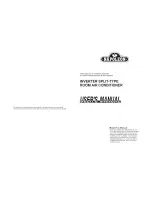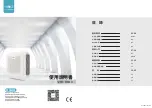
Ð 176 Ð
The damper has 2-directional output and realizes OPEN/CLOSE usinga steppingmotor.
Damper control functions only when the Air outlet SW is set to Ò
Ó.
(1) OPEN operation
Start up the damper towards OPEN direction by overall angle width [DNPALD1]. When the start up completes, turn off
the output.
(2) CLOSE operation
Start up the damper towards CLOSE direction by overall angle width [DNPALD1] + tightening angle [CNPPLS1]. When
start up completes, turn off the output.
Initial operation is performed only once when the main power is switched ON. The damper should be operated as follows
due to its structure.
①
Damper OPEN (Damper limit SW = OFF signal)
②
Damper CLOSE (Damper limit SW = ON signal)
Its travel speed is pulse output speed [DNPPPS].
Monitoringof damper limit SW is inhibited duringstart up and for 2 seconds after startingup the damper, after which the damper
limit SW will be monitored.
(1) Damper limit SW signal at the completion of initial operation is monitored. If the signal is OFF, it is judged as malfunction and the
malfunction mode is entered immediately.
(2) Monitoringof damper limit SW signal is inhibited while the unit is stopped.
(3) Damper limit SW is always monitored while the unit is in operation. Right after the unit operation is started, however, malfunction
judgment is not made and the damper performs the following operation.
When ÒONÓ signal is detected (Normal signal): Start up towards CLOSE direction by tightening angle.
When ÒOFFÓ signal is detected (Abnormal signal): Start up towards CLOSE direction by overall angle width plus tightening angle.
(4) After performingthe above operation, malfunction judgment will always be carried out. If abnormality is detected for 4 times
consecutively within 30 minutes, the malfunction mode is entered at the moment the 4th abnormality is detected.
In the case where 3 or less abnormality are detected, retry operation is performed.
Abnormal OPEN location
If the signal is ÒONÓ, the damper is judged to be at CLOSE location (abnormal). The retry operation, which is the same as OPEN
operation by overall angle width, will be performed.
Abnormal CLOSE location
If the signal is ÒOFFÓ, the damper is judged to be at OPEN location (abnormal). The retry operation, which is the same as CLOSE
operation by overall angle width + tightening angle, will be performed.
(5) Self diagnosis mode of the damper is indicated by ÒTimer lamp blinks for 8 timesÓ.
! "# $ %
The damper functions only duringheatingand coolingoperation. It stays closed duringother operatingmodes.
& $
The damper is open duringnormal heatingoperation (except for 10 seconds after thermo resumes, duringsleep operation
and duringnice temperature). It is closed duringother types of operation.
The damper closes immediately if the damper changeover SW is set to ÒmanualÓ. When the damper is starting up, however,
it closes only after open operation completed.
● Main operation ON/OFF (with preheating)
Main Power
Remote controller operation
Operatingcondition
Operation lamp
Indoor
Upper fan
Lower fan
Compressor
Limit SW
Damper
Close
(Limit SW is ON)
Open
(Overall angle width)
DNPFLG (0)
DNPFLG (1)
DNPSTS
1
1
1
Period 1 Period 2
Open sequence
Period 3
1
1
0
2
2
3
4
0
0
0
0
Operation starts
Operation stop
Stop
ON
ON
ON
Stop
PreheatingNormal operation
Settingfan speed
Settingfan speed
Initial completed
(Initial completed)
Tightening
angle
Tightening angle
Overall
angle
width
Overall angle width
Overall angle width
+
Tightening angle
Overall angle width
+
(Initial period)
(Closed period)
(Closed period)
(Opened period)
Note: Regardless of ÒONÓ and ÒOFFÓ of the limit SW, the damper
performs OPEN operation when the power is switched on.
Summary of Contents for RAD25QH4
Page 3: ... 0Ω 112 3 4 1 5 6 7 7 8 9 4 DANGER ...
Page 10: ... SPECIFICATIONS EU1013DD 2 ...
Page 11: ... EU1013DD 2 ...
Page 31: ... 0 1 2 3 1 4 5 6 4 7 8 9 4 1 2 1 0 ...
Page 32: ... 1 2 3 4 1 2 5 6 2 5 6 7 2 28 2 9 9 1 1 2 7 6 8 2 8 ...
Page 33: ... 0 1 0 1 1 1 0 1 1 2 3 4 0 5 3 6 7 3 6 7 8 3 39 3 3 8 7 9 3 9 2 2 1 2 2 ...
Page 35: ... 0 1 2 3 2 456 7 0 1 8 9 5 5 8 3 8 5 3 4 4 8 8 3 8 3 3 7 A 3 3B C 9 8 D ...
Page 127: ... 0 1 22 3 3 4 567 89 5 8 8 3 567 89 ...
Page 152: ... 0 1 0 2 3 5 6 1 7 6 6 3 5 3 5 8 9 9 ...
Page 154: ... A 0 11 2 3 1 1 3 1 3 4 4 5 A 6 8 3 1 11 1 1 1 5 A 6 9 ...
Page 162: ... Mode Refroidissement 0 1 2 3 4 55 6 7 85 9 6 7 A 75 1 B B 6 A 75 1 B B C 9 ...
Page 183: ... 0 1 2 3 4 0 3 4 5 1 5 5 6 7 8 1 5 1 9 1 0 5 1 9 9 5 ...
Page 184: ... 01 0 2 3 4 3 0 5 3 3 0 3 0 067 8 3 0 7 3 0 3 9 3 9 1 9 1 0 A 0 B ...
Page 188: ... 0 2 2 3 4 567 3 4 567 3 4 567 3 4 567 8 9 2 8 9 2 4 6 0 0 6 0 4 ...
Page 194: ... 1 2 3 4 5 6 7 6 6 7 6 8 9 9 9 8 9 9 9 8 9 9 5 9 9 5 9 9 A A 2 3 4 9 9 ...
Page 203: ... 0 1 0 0 2 0 3 3 4 3 3 5 5 0 0 0 0 5 5 0 5 0 1 32 6 6 6 76 0 8 9 0 0 0 0 ...
Page 204: ... 0 1 2 3 4 5 6 2 2 3 7 7 1 3 7 2 2 8 7 1 2 29 9 5 6 2 3 2 2 2 29 9 5 9 0 3 7 2 2 4 0 0 3 6 ...
Page 207: ... 0 1 2 1 0 1 3 41 3 41 1 2 1 ...
Page 211: ... 0 1 23 4 1 03 4 1 4 1 5 6 4 7 8 7 7 8 7 7 8 7 7 8 7 5 0 9 0 9 5 5 5 5 5 5 5 5 5 5 ...
Page 212: ... 0 1 0 234 0 5 134 5 0 0 5 0 0 5 6 7 8 9 8 8 9 8 8 9 8 8 9 8 6 1 1 0 0 ...
Page 214: ... 7 Circuit de contr le facteur de puissance 0 ...
Page 217: ... 0 0 1 2 3 4 ...
Page 221: ... AT STARTING OPERATION 0 0 OTHERS 1 2 1 3 2 0 0 ...
Page 226: ... 0 0 1234 5 5 6 7 8 8 0 0 0 7 0 9 0 0 2 0 50 0 0 0 0 0 0 9 0 0 0 0 0 0 0 5 0 0 0 0 0 0 ...
Page 228: ... FIXATION 0 1 2 3 1 40 0 1 2 3 1 1 6 2 3 1 22 7 8 9 2 3 1 6 8 2 40 0 2 3 1 0 0 6 ...
Page 230: ... 01234 54 567 8 94 4 4 8 8 2 8 8 7 FIXATION FIXATION ...
Page 232: ... 0 1 2 3 4 1 1 6 7 8 7 7 9 8 0 3 4 8 FIXATION 3 1 3 1 ...
Page 236: ... FIXATION 0 1 2 2 3 4 5 6 ...
Page 249: ... 0 1 1 234 354 64 234 354 74 8 2349 354 4 49 64 49 64 239 354 74 7 1 ...
Page 280: ...Ð 307 Ð MODEL RAD 25QH4 RAD 40QH4 MODELE 67 11 ...
Page 293: ...TC NO 0757EF RAF 25NH4 RAF 50NH4 RAD 25QH4 RAD 40QH4 RAM 70QH4 RAM 80QH4 ...
















































